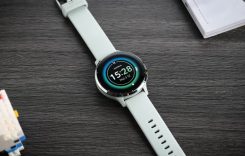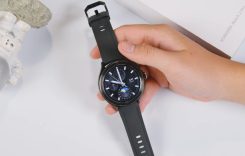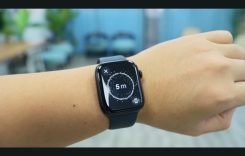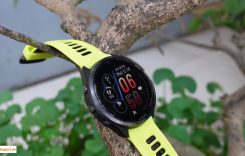The Samsung Galaxy Watch 4, the latest iteration in Samsung’s smartwatch lineup, marks a significant leap forward in terms of design, performance, and health tracking capabilities. As a flagship wearable, the Galaxy Watch 4 combines the power of Samsung’s hardware with the versatility of Google’s Wear OS, creating a compelling smartwatch experience. In this comprehensive review, we will explore the key features, design, display, performance, health and fitness tracking capabilities, battery life, and overall user experience of the Samsung Galaxy Watch 4.
Design:
The Galaxy Watch 4 introduces a fresh design language that departs from its predecessor, embracing a sleeker and more modern aesthetic. The watch features a circular Super AMOLED display with slim bezels, creating an immersive visual experience. It is available in two sizes: 40mm and 44mm, catering to different wrist sizes and preferences.

Samsung offers a variety of watch faces and customizable bands, allowing users to personalize their Galaxy Watch 4 to match their style. The watch is constructed with a combination of aluminum and Gorilla Glass DX, striking a balance between durability and a premium feel. The physical rotating bezel, a signature feature of Samsung’s smartwatches, provides a tactile and intuitive method for navigating through the watch’s interface.
Display:
The Galaxy Watch 4’s display is a standout feature, leveraging Samsung’s expertise in Super AMOLED technology to deliver vibrant colors, deep blacks, and excellent visibility in various lighting conditions. The display is protected by Gorilla Glass DX, offering durability and scratch resistance. The always-on display functionality ensures that users can glance at the time and other essential information without raising their wrist.

The watch’s display supports adaptive brightness, adjusting to the ambient lighting for optimal visibility. The high resolution and pixel density contribute to sharp and detailed visuals, making the Galaxy Watch 4 suitable for viewing notifications, messages, and fitness metrics with clarity.
Performance:
Powering the Galaxy Watch 4 is Samsung’s Exynos W920 dual-core processor, a dedicated chipset for wearables. The Exynos W920 brings improvements in performance and energy efficiency, ensuring smooth navigation and responsive interactions. The watch benefits from 1.5GB of RAM, providing ample memory for multitasking and running apps without lag.

The combination of the Exynos W920 chip and Wear OS 3.0, co-developed by Google and Samsung, creates a cohesive and optimized software experience. The user interface is intuitive, and app launches, as well as transitions, are swift and seamless. The performance improvements contribute to an overall fluid and enjoyable smartwatch experience.
Health and Fitness Tracking:
The Galaxy Watch 4 places a strong emphasis on health and fitness tracking, incorporating a range of sensors and features to cater to users with diverse wellness goals. The watch includes an optical heart rate sensor, an ECG sensor, a blood pressure monitor, and a body composition measurement tool. These features contribute to a comprehensive view of the user’s cardiovascular health and fitness levels.

The onboard GPS enhances the accuracy of outdoor activities tracking, allowing users to monitor their running, cycling, and hiking routes. The watch supports a variety of workout modes, from traditional exercises to newer activities like rowing and virtual group workouts.
Samsung’s BioActive Sensor integrates optical and electrical sensors to measure the user’s body composition. This feature provides insights into metrics such as skeletal muscle mass, body fat percentage, and water retention, offering a more holistic approach to fitness tracking.
The Galaxy Watch 4 also introduces the Body Composition Measurement app, allowing users to track their body composition trends over time and make informed decisions about their fitness and nutrition routines.
Battery Life:
The battery life of the Galaxy Watch 4 is in line with its predecessors, offering a full day of usage on a single charge. The specific battery life can vary based on usage patterns, enabled features, and the watch’s size. While the Galaxy Watch 4 might not be class-leading in terms of battery longevity, it compensates with the convenience of fast charging.
The watch supports fast wireless charging, allowing users to quickly recharge their device when needed. A short charging session can provide enough power for a full day of use, minimizing downtime and ensuring that the watch is ready to go when the user needs it.
Software Experience:
The Galaxy Watch 4 runs on the new Wear OS 3.0, a collaboration between Google and Samsung. This iteration of Wear OS brings a unified platform that merges Samsung’s Tizen OS features with Google’s ecosystem, creating a seamless and cohesive software experience.

The user interface is intuitive, with a redesigned app drawer and improved navigation. The integration with Google services, such as Google Maps and Google Play, enhances the watch’s versatility. Users can download apps directly from the Google Play Store on the watch, expanding the device’s functionality.
The Galaxy Watch 4 benefits from Samsung’s robust app ecosystem, with a variety of apps optimized for the smartwatch form factor. The watch also integrates seamlessly with Samsung’s Galaxy ecosystem, offering a unified experience for users who own multiple Samsung devices.
Ecosystem Integration:
The Galaxy Watch 4 is designed to seamlessly integrate into Samsung’s broader Galaxy ecosystem, creating a cohesive and interconnected user experience. The watch pairs effortlessly with Samsung smartphones, providing quick access to notifications, calls, and messages directly from the wrist.
Users can also leverage the watch’s compatibility with other Samsung devices, such as Galaxy Buds, to enhance the audio experience. The watch’s integration with Samsung Health creates a centralized hub for tracking and analyzing health metrics, providing a comprehensive view of the user’s well-being.
Conclusion:
The Samsung Galaxy Watch 4 represents a significant advancement in the realm of smartwatches, combining a refined design, powerful performance, and robust health tracking capabilities. The collaboration between Samsung and Google in developing Wear OS 3.0 creates a harmonious software experience that leverages the strengths of both ecosystems.
With its vibrant Super AMOLED display, extensive health and fitness features, and seamless integration into the Samsung and Google ecosystems, the Galaxy Watch 4 stands as a versatile and compelling smartwatch option. Whether you’re a fitness enthusiast, a tech aficionado, or someone seeking a stylish and functional accessory, the Galaxy Watch 4 delivers a holistic and enjoyable smartwatch experience.









